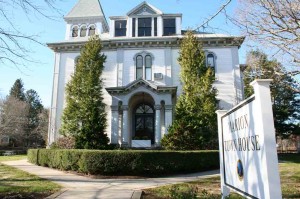Imminent financial deficits and the uncertainty over the future of the town’s sewer treatment facility are what drove the Marion Water Rate Study Committee to recommend on August 18 that the Marion Board of Selectmen adopt water and sewer rate increases for the current fiscal year.
The last time the Town raised the water and sewer rates was eight years ago back in 2007, when, at that time, the town committed to performing annual reassessments of the Town’s water and sewer rates.
“This year, regrettably, we will be making a recommendation for a rate increase,” said Marion Town Administrator Paul Dawson. He said it was important to note: “Remember that this is actually three years later than we had predicted [rates would go up].”
Most residents, Dawson noted, belong in the Tier I consumer group. The 2.5% increase, talking dollars and cents, translates into a $14 increase each billing cycle for an average residence of 2.5 people, based on average water consumption.
For water-only customers, the increase averages at $1.77 each billing cycle, and sewer-only customers would see an increase each cycle of about $12.22.
“We will revaluate this every year,” said Dawson.
If the selectmen vote to adopt the new rates, then come September, Tier I water consumers will see their base water charge – the standard payment made by all water consumers – rise by 2.5% annually, beginning this fiscal year 2016, and continue to increase by 2.5% each following year through 2018.
Tier II and III consumers will witness a 3% increase in the water rate, which will be adjusted further in the following years through 2018 by 15%.
All sewer customers will witness a 2.5% increase in their sewer rate as well.
As Dawson and the committee analyzed the numbers, the budget, and the projected shortfalls that would eventually amount to over $100,000 in sewer alone, they determined that the increase was necessary to keep both the water and sewer operations from falling too deeply into a deficit.
The rate increases help cover the costs of maintenance, future improvements, and chemicals for water treatment; the rate increases do not, however, account for what Dawson called “the elephant in the room,” the unknown result of the Town’s National Pollutant Discharge Elimination System (NPDES) permit that could result in an excess of $20 million in costs for the town.
“Obviously, we’ll have to raise rates accordingly,” said Dawson, once the Mass DEP issues a decision in the fall on whether or not it will allow the Town to explore alternative ways in which to comply with the strict environmental and pollution standards the DEP issued this year.
Water consultant for the Town, John Gregory, explained how the committee extrapolated the data and determined the rate increase percentage. The bottom line, he said, was the surplus and deficit number and its propensity to plunge deeper into the negative over the next three years.
After brainstorming, Gregory said the rate increases were the best way to even out the surplus and deficit number and come close to breaking even each subsequent year.
“This was the best means that we could come up with,” said Gregory. The way that is least problematic for the townspeople, Gregory stated, but still meets the needs moving forward. “And the NPDES permit is still out there looming. We don’t know how this is going to work into this.”
Dawson emphasized that the Town has internally done its best in this situation, and he praised both the Water Rate Study Committee and the Department of Public Works.
“It’s a great thing that we’ve been able to hold this off for a few years,” said Board of Selectmen Chairman Stephen Cushing. “We’re at a point where we have to do it.”
The board refrained from voting that evening in order to allow residents and interested parties to learn about the rate increases and voice their concerns and opinions during a special public meeting, which the selectmen scheduled for August 25 at 7:00 pm at the Marion Music Hall.
Also pertaining to the Water Department, Dawson said recent water quality samples showed high amounts of coliform at several drinking water source sites, resulting in a thorough chlorination of each of several water tanks. On August 14, resampling was done and chloroform results were high again.
“Not e-coli,” said Dawson. “Coliform. This has never been a boil water situation.”
The positive results triggered three required subsequent retests.
“And I’m happy to report, as of today, the results … came back and everything appears to be clean,” said Dawson.
Dawson said a detailed water quality report would soon be disclosed to the public in a formal press release.
The next scheduled regular meeting of the Marion Board of Selectmen will be September 8 at 7:00 pm at the Marion Police Department conference room.
By Jean Perry
